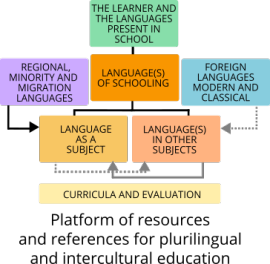Three fundamental and complementary tools for the implementation of plurilingual education
A detailed presentation of these 3 Guides is also provided on the Language Policy Portal
Jean-Claude Beacco, Michael Byram.
The aim of the Guide is to offer an analytical instrument which can serve as a reference document for the formulation or reorganisation of language teaching in member states. Its purpose is to provide a response to the need to formulate language policies to promote plurilingualism and diversification in a planned manner so that decisions are coherently linked. Accordingly, the Guide does not promote any particular language education policy but attempts to identify the challenges and possible responses in the light of common principles.
The document is intended for those who influence, formulate and implement language education policy at any level. It presents approaches to the development of policies rather than policies as such, and is designed to accommodate the needs of different education contexts.
A detailed description of its content and of the two versions as well as the Reference Studies are provided on the Language Policy Portal (together with an overview of the 3 guides).
See also section “The Learner” ► Further Language Policy Resources
Jean-Claude Beacco, Michael Byram, Marisa Cavalli, Daniel Coste, Mirjam Egli Cuenat, Francis Goullier, Johanna Panthier.
This Guide is intended to facilitate improved implementation of the values and principles of plurilingual and intercultural education in the teaching of all languages - foreign, regional or minority, classical, and languages of schooling. While primarily intended for those responsible for curriculum planning, it is ultimately aimed at everyone involved in teaching.
It is designed to encourage the global, explicit and convergent consideration of the language of schooling and the other languages taught and used at school as well as the promotion of cross-cutting elements that help interlink the different kinds of language teaching. It proposes practical approaches to developing curricula, illustrated by scenarios and other devices, for the implementation of plurilingual and intercultural education. It has two accompanying satellite studies.
These different contents are described in detail in the section on "Curricula and Evaluation" ► Reference Texts.
A detailed description of this Guide and of the satellite studies is also provided on the Language Policy Portal (together with an overview of the 3 guides)
Jean-Claude Beacco, Mike Fleming, Francis Goullier, Eike Thürmann, Helmut Vollmer, with contributions by Joseph Sheils.
The Handbook explains why the language dimension is key to closing the achievement gap and describes the components involved in the use of "academic language" (the formal language used by the different academic subjects) while proposing strategies for teaching that takes account of language issues horizontally (across the different disciplines) and vertically (from one level of teaching to another). It also looks at different options for the devising of curricula, the training of teachers and the quality of education, from the institutional level to the local, regional and national levels of the education system.
These different contents are described in detail in the section on "Language in other subjects" ► Handbook.
A detailed description is also provided on the Language Policy Portal together with an overview of the 3 guides.



